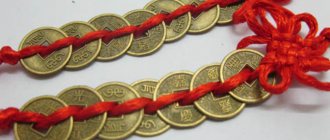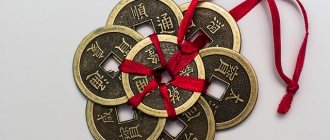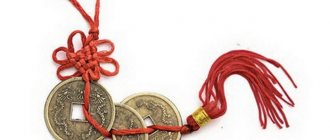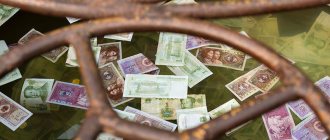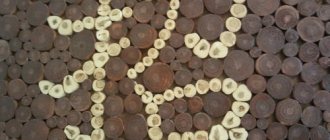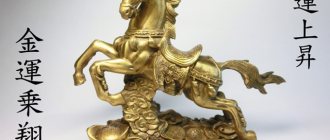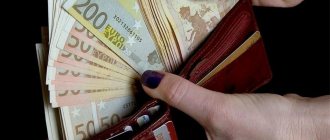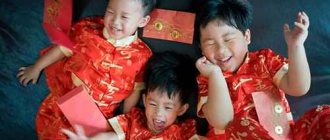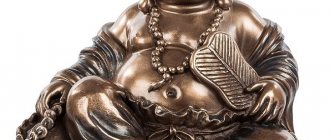Hieroglyphs have always evoked awe and respect. This ancient form of writing even got its name from the Greek ἱ&epsilon,ό&sigmaf, (hieros) sacred and &lambda,ύ (glipho) cut out, carve. That is, sacred carved letters. In an era of general illiteracy, the awe was explained by the fact that scribes were treated as people possessing secret knowledge that could only be shared with initiates. Nowadays, people are so accustomed to letters and the alphabet that it is difficult to imagine that other forms of writing exist. And the mysterious, as we know, attracts.
Now hieroglyphic writing has been preserved only in the Chinese and Japanese languages and is associated with the culture of these countries. You can also mention Korean hancha, but they are extremely rare: the DPRK abandoned them in 1947, and South Korea also almost never uses them. Coins with hieroglyphs in Japan and China are found everywhere, as is everything that contains at least some inscriptions.
Description of coins
Chinese coins are round in shape and have a square hole in the middle. The active side signifies yang energy and always contains four characters. The passive side, responsible for yin, has two symbols.
Typically these coins are made of copper. Some of them have distinctive features in the form of specific images. It could be a sword, a dragon, a phoenix. Such coins are designed to protect a person from evil forces.
Two sides of a Chinese coin with a square hole
Japanese coins before the end of World War II
During the subsequent Taisho and Showa eras and until 1945, Japanese coins did not change much. In the photo above you can see 50 sen, which does not contain Arabic numerals. On the obverse in the center you can see the same chrysanthemum flower. Along the edge there are inscriptions in Japanese, on top: 本日大 - GREAT JAPAN, below: 昭和十一年 - 11TH YEAR OF SHOWA, that is, 1936 according to the Gregorian calendar. On the reverse there is a chrysanthemum flower on top, 50 sen on the bottom in Chinese numerals: 五十銭. To the left and right of the inscription are two doves, symbolizing longevity.
Coins as a money talisman
Copper money, tied with a red ribbon or thread, is often used as a talisman. This amulet has the following properties:
- promotes business development;
- helps in achieving the goal;
- attracts wealth to the house.
It is necessary to tie the coins with a ribbon so that the special symbols are located on top. Instead of a red bandage, you can use a gold one. The main thing is that it is durable.
Particularly prized are copies produced between the 17th and 20th centuries. Coins from Qian Long and Kang Xi work well as talismans. They are considered a symbol of financial luck. They are stored in a red envelope, a wallet and on a money tree.
What properties were endowed with Chinese coins with a square hole?
There are a large number of rituals using metal money paraphernalia. Widely known and used by many - a coin intertwined with red or gold thread. Basically, these attributes are aimed at attracting health, wealth and success.
It is worn around the neck or on the wrist, like a money talisman, to attract financial success, to attract fortune, like a good luck coin, for family well-being. By the way, if you don’t know what the health talisman is called, then this is the coin that represents this symbol.
Absolutely everything is important to create a working mascot. How many coins are used, their alternation, the method of weaving the lace and how it can be tied.
To create a talisman with metal money, a red cord is often used. The color red symbolizes prosperity, attracts prosperity to the home and scares away evil spirits. The red ribbon that connects the coins means indestructibility and naturalness.
Based on what amulet the amulet is created for, the number of coins will depend. The infinity knot with which metal money is tied is very important. It is designed to expel the aggressive energy of Sha Qi.
How many coins should there be?
You can use one or more coins as a money talisman. The quantity should be chosen based on the purpose and situation:
| Number of coins | Properties | How to use |
| 1 | Attracts wealth | You can hang it on the front door handle, after tying a red thread on it, or put it under the rug, in a folder with documents |
| 2 | Symbolize the accumulation of finances, protect from evil | Must be carried with you or put in your favorite box |
| 3 | Attract financial well-being from three sources at once | Can be placed on the wall, placed under a money tree or buried in a plant pot |
| 5 | Increase the income of trade workers | It is recommended to place it under the door mat |
| 6 | Represent heavenly luck | The best place for storage is the north-west of the room |
| 8 | Attract wealth into the house from all sides | It is recommended to locate it in the south-eastern sector of the home |
| 9 | They attract wealth not only to the owner, but also to all his descendants of the next 9 generations | Coins from the Qin Dynasty are suitable, they are placed in the southeast and northwest of the house |
The numbers 4 and 7 are considered unlucky. This number of coins is not suitable as a talisman.
Expert opinion
Melnik Dmitry
feng shui master
Risky people who bet money on races or like to play the lottery need to keep a Chinese coin in the southeast of their home near the door. It can also be worn around the neck by passing a red string through the hole. Such a talisman will attract good luck and make sure that fortune does not turn away from a person.
It is not necessary to put Chinese coins on public display. They can be hidden from prying eyes so that others do not ask many questions.
Japanese coins with floral and plant motifs
In Asian countries, floral motifs are found on coins more often than in the rest of the world. This fact is explained simply: people of the East are very fond of flowers for their beautiful shapes, alluring aromas, and endow many species with symbolic meanings. In addition, certain flowers grow only in certain countries and are therefore strongly associated with them. For example, everyone knows that Japan is the country of sakura and chrysanthemums. By the presence of these colors on the reverses and obverses, Japanese coins are easy to identify and distinguish from others. What other flowers and plants of the land of the rising sun are reflected in numismatics? What does the giant paulownia tree symbolize, and how does the plum blossom on the coins differ from the cherry tree?
Flower cult in Japanese culture
In all spheres of Japanese art (be it literature, cinema or painting) there are images of flowers as stable symbols of one or another phenomenon. Camellias, chrysanthemums, sakura, hydrangeas, irises and other flowers create a complex subtext, often understandable only to the Japanese viewer/reader. In everyday life, the Japanese also love to grow and care for fresh flowers. The cult of flowers can be called one of the characteristic features of Japanese culture, where the moon and snow are also highly revered. There is even a special aesthetic concept “hanami”, which means “look at flowers”, enjoy their beauty and rejoice at this miracle of nature.
Japan, cherry blossom season
Sakura (Japanese cherry)
“The cherry tree is a season of renewal, heralded by the fresh green of new foliage, while a little later the fall of the cherry blossoms gives the landscape a melancholy note with a reminder that as the petals of flowers are blown away by the wind, so is human life,” writes Charles Dunn in the book "Traditional Japan". Cherry blossoms begin to bloom in Japan at the end of March and truly transform the country's landscape, turning it white and pink. At this time, the Japanese like to have picnics and admire the cherry blossoms.
The spring night has passed.
The white dawn turned around
A sea of cherry blossoms.
Macio Basho
The cherry blossom has remained a fixture on the Japanese 100 yen coin since 1967. Three large sakura flowers with leaves and buds occupy the reverse of the coin; hieroglyphs above and below indicate the denomination and the name of the issuing country, Japan; the obverse presents the denomination and an inscription of hieroglyphs: the name of the era, the year of the reign of the emperor. The circulation of everyday coins issued in the 60s is huge. For the first year of minting it is 432,200,000 pieces. In subsequent years it remains just as high (for example, in 2004 - 204,623,000 copies). 100 yen with cherry blossoms are still in circulation today.
Japan, 100 yen 1994. Sakura
Rice sprouts
Rice is one of the most important components of Japanese culture. For many centuries, rice cultivation was the main occupation of the Japanese and formed the basis of their daily life. “The peasant stopped threshing rice for a moment, / Looks at the moon,” wrote the 17th century Japanese poet and wandering philosopher Mazio Basho, emphasizing the importance and continuity of the connection between man and rice. A connection that can only be interrupted by an even more important activity - contemplation of the beautiful Moon.
Rice influenced not only the Japanese worldview, but also their social life. There is a sociological theory that states that the family and community in Japan were shaped by the characteristics and needs of rice cultivation. Since ancient times, this cereal crop has symbolized agriculture, prosperity and well-being. “What bliss! / A cool field of green rice... / The murmur of water...” - we meet from the same Basho. Contemplation of a rice field helps the author find harmony of spirit, calmness and peace.
Japan, 5 yen 1979. Rice
Ears, wreaths and flowers of rice can be seen on various Japanese coins minted in the 19th and 20th centuries. The obverse of the bronze 1 sen coin, issued since 1898, depicts a wreath of rice ears (on the reverse is a chrysanthemum stylized as a sun). A lush bouquet of rice ears is featured on the reverse of the 100 yen silver coin minted by the Osaka Mint from 1959 to 1966. The everyday 5 yen coin since 1949 has featured a rice sprout on the obverse, symbolizing agriculture. Rice sprouts are also often found on coins of other Asian countries. Blooming rice is represented on coins of South Vietnam, Thailand, and Burma.
Chrysanthemum as a national symbol of Japan
The name chrysanthemum literally translates as “golden flower” - a symbol of autumn. There are many myths and legends associated with this plant in Japan; an annual holiday is dedicated to it. It is held on the 9th day of the 9th month according to the lunar calendar. On this day, the Japanese make flower garlands, ikebana, have fun and read poetry.
Seen everything in the world
My eyes are back
To you, white chrysanthemums.
Issho Kosugi
“The chrysanthemum is the main distinctive symbol of Japanese coins, and their resemblance to the rising sun (a popular obverse motif) explains their appearance. <…> Most coins issued in Japan since the introduction of Western-style coins in 1873 featured the chrysanthemum at the top of the reverse, but on the 1898-1915 bronze hay it was the central motif of the obverse. On many coins, a wreath of chrysanthemum leaves surrounds the denomination. <…> In the post-war years, a combination of symbolism and graphics developed: sometimes images that were previously conveyed symbolically were designed more realistically, for example, on the 50 yen of 1955-58, the chrysanthemum was depicted as a real flower, with leaves and a stem,” the famous historian, writer and numismatist James Mackay in his Encyclopedia of Coins.
Japan, 50 yen 2005. Chrysanthemums
And the most popular coin with the image of a chrysanthemum is perhaps the 50 yen, which has been in circulation since 1967. This is a coin with a round hole in the center, around which there are chrysanthemum flowers with leaves: two flowers on the left and one on the right. The reverse features the denomination and an inscription in a semicircle of hieroglyphs.
Chrysanthemums are also present on commemorative commemorative coins: 500 yen from 1993 is a prime example of this. This coin was issued in memory of the solemn event - the wedding of Crown Prince Naruhito and diplomatic service employee Owada Masako. In the center of the wreath is the imperial seal in the form of a stylized chrysanthemum. The 16-petal yellow or orange flower has served as the emblem of Japanese emperors and their family members since the Kamakura period (1185-1333). Other representatives of Japanese society were prohibited from using this symbol. But over time, the chrysanthemum ceased to be a purely imperial privilege, and now it can be found in parliament and various diplomatic institutions. And since Japan does not have an official state emblem, the imperial stamp also sometimes performs its functions.
Paulownia - personal sign of the emperor
Paulownia fallen leaf
It makes the road so difficult,
Do not trample the paths.
The rest of hope is gone,
That my friend will come to me.
Sikisi-Naisinno, lane. V.Markova
In Japan, the paulownia tree, named after the daughter of Emperor Paul I, Anna, Queen of the Netherlands, is known by everyone under the name “kiri”. And they have known it for more than 4000 years. Kiri means "life", symbolizes good luck and is considered a sacred tree. Kiri or paulownia as a decorative element is present on the emblem of the Cabinet of Japan (a golden flower on a blue background) and the Order of the Rising Sun (this honorary order has been awarded since 1875 for special services to the state). In addition, paulownia is considered a personal sign of the emperor. The flower can be seen in this capacity on the 500 yen coin, first minted in 1982. Its appearance was caused by inflation. The obverse depicts the said flower of the fast-growing kiri tree. The name of the state - Japan and the denomination (the hieroglyph under the flower) are represented in the form of hieroglyphs. On the reverse there is a composition of the year of issue, denomination, images of bamboo and tangerine.
Japan, 500 yen 1986. Paulownia
Japanese commemorative coins with flowers
Special or commemorative coins with floral motifs are, oddly enough, quite rare in Japan. Just a few examples can be given of this. In 1964, a 1000 yen coin was issued. The occasion was the Tokyo Olympic Games. The obverse of this coin depicts Mount Fuji in a wreath of cherry petals. And in 2008, the Japanese Mint launched an interesting series of “47 Prefectures” commemorative coins. Prefectures are administrative divisions of Japan. In total, the country's territory is divided into 47 prefectures. In honor of the 60th anniversary of local government, it was decided to “reward” each territory with a bimetallic coin dedicated to it. The series is now complete. The obverse (it is the same for the entire series) depicts an ancient coin, the name of the series in English and the numbers 60 and 47 (they replace each other from different angles). 60 denotes the 60th anniversary of the enactment of the law establishing prefectures, which occurred in 1947. The reverse of the coins depicts key landmarks of the prefectures. Some of them are accompanied by floral elements: branches of plum, iris, rhododendron...
So on the 2009 500 yen coin “Ibaraki” we will see a branch of a blossoming plum and an image of the Kairakuen Garden in the city of Mito (Ibaraki Prefecture), which is one of the three great gardens of Japan. It was erected in 1842 by order of the Japanese ruler Tokugawa Nariaki. Tokugawa was very fond of plum trees. This determined the concept of the garden and its landscape dominant. As a result, a giant plum grove was planted here, uniting 3,000 trees (more than 100 different species) on an area of 130 thousand square meters. Japanese plums (ume) are often confused with sakura. Their flowers are really similar. But plum flowers are darker, and plum trees begin to bloom earlier - in February, early March, thereby signaling the onset of spring. That is why the plum in Japan is a symbol of spring, as well as a symbol of the samurai. During the flowering season, the Mito Plum Festival begins in Kairakuen Garden. It has been held for many years in a row, attracting thousands of tourist visitors from all over Japan and other countries.
Japan, 500 yen 2009. Series “47 Prefectures of Japan – Ibaraki”
The 2010 500 yen coin from Gifu Prefecture shows us another floral motif. Its obverse depicts the flowers of the Chinese milk vetch, a leguminous plant from the genus Astragalus, as well as the traditional houses of the historical village of Shirakawa, with steep thatched roofs. The unusual steepness of the roofs is typical for areas with heavy rain and snowfall. The unique village is under UNESCO protection.
Japan, 500 yen 2010. Series “47 Prefectures of Japan – Gifu”
An image of another flower popular in Japanese culture, the iris, can be seen on the 2010 500 yen coin from Aichi Prefecture. On the reverse of the coin there is an image of the administrative building of Aichi Prefecture (Nagoya city) and the smooth iris flower, which occupies a special place in the heart of every Japanese. After all, according to legend, it was the first to bloom on earth in those times when people did not yet exist. And another legend says that the iris helped change the fate of the unfortunate girl. She was unhappy because she was born in Japan with blond hair. And people made her an outcast. But one day the girl washed her hair with an infusion of an unusual flower, and her hair turned golden-copper. People thought that the sun had made the girl’s head golden. And the iris took pride of place in the imperial garden, and has since been considered a medicinal plant. In the old days, wreaths were knitted from iris flowers and worn around the neck against colds. As an adornment and decorative element, iris is also often used in hairstyles, outfits and interior design.
Japan, 500 yen 2010. Series “47 Prefectures of Japan – Aichi”
The theme of flowers on Japanese coins is broad and beneficial, helping to understand the peculiarities of the culture and worldview of the inhabitants of the land of the rising sun. However, there is no point in stopping at Japan. The collection of “flower” coins in the future can easily be supplemented by its closest neighbors: China, Vietnam, Thailand and Korea, where the cult of flowers is no less popular.
Tatiana BULYGINA
Other types of Chinese coins
It is customary to carry a coin with two dragons in a pocket or purse and hide it under the mattress. It is used to attract love and maintain harmony in marriage.
Copper money with the image of Shou Sin will help improve your health. Often storks, deer and peaches are drawn on it, and on the other side there is a hieroglyph meaning longevity.
A specimen with five bats is considered rare. Such a talisman is designed to provide its owner with strong protection and support.
A large Chinese coin with a square hole and the image of Zhong Li Quan is a powerful amulet. It is hung in the house in the assistants' area or carried with you.
Before using coins, it is important to clean them of foreign energy and soak them in salted water for three days. In this way, you will be able to activate the wealth sector and attract success and prosperity into your life.

